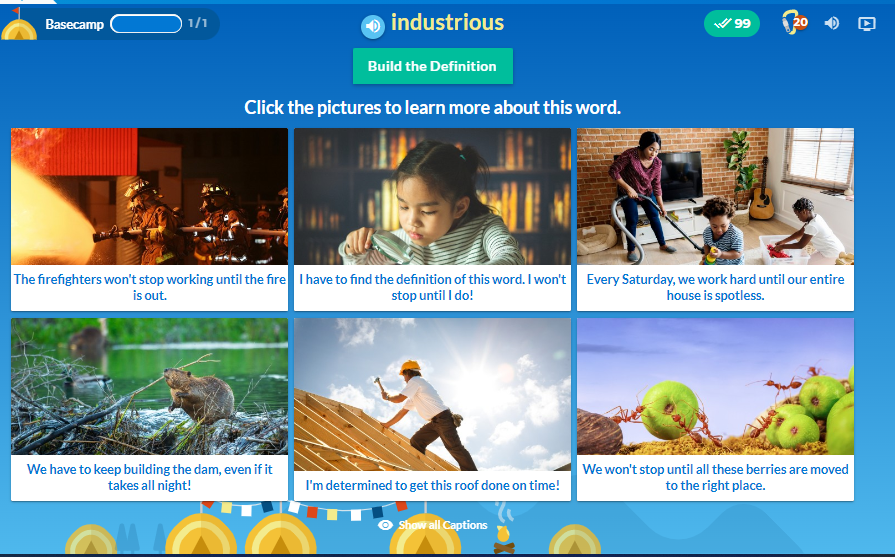Generative Vocabulary
Did you know that the Oxford English Dictionary updates its collection of words four times a year? Thanks to the June edition, we can now use terms such as ankle-biter, dwarven, ignorati and stress bunny with authority. What started as a curious side track, however, turned into a deep reflection on the importance of teaching words generatively.
What is generative vocabulary?
I first heard the term “generative vocabulary” from Shane Templeton when he presented on behalf of InferCabulary last year. Five minutes of additional research brought me to Elfrieda Hiebert who has a variety of articles on the subject, a book, and an entire website: textproject.org.
Employing a “generative approach to vocabulary learning” means showing students how words have key features and contexts that connect to other words. Teaching words in a generative manner with semantic connections is more efficient and effective than what most of us know as “traditional vocabulary instruction”.
The latter approach typically included 8-10 target words for which students memorize provided definitions, or are required to look up in a dictionary and then memorize. These words are taught one at a time, and the measure of “success” is a score on a Friday quiz. The quiz often requires students to use the newly “learned” words in novel sentences, which is close to impossible due to a lack of background knowledge about the word as well as how the word might change grammatically in different sentence structures. Rarely are these new words utilized spontaneously. Even if a student recognizes the word “consume” and recalls that it has something to do with eating, it will be of little help in comprehending a sentence such as, “The visions of a new puppy consumed his every thought”.
Teaching generative vocabulary means that students learn the target word at the same time they learn other sets of related words. Semantic mapping has always been a staple practice of language intervention, so while the “generative” label was new to me, the practice was not.
Generative vocabulary & Semantic Mapping
Somewhere in my basement I have a semantic map for “industrialization” that evolved on my office wall for many years as a Speech-Language Pathologist and likely included collections of related words in groups such places; tenement, rural, urban, factory, city, people; muckraker, progressive, union, laborer, actions; strike, manufacture, invent, pollute, transport, traits/descriptors; conditions, squalor, poverty, dangerous, hazardous, crowded, infested, machines/materials; textile, steel, railroad, assembly line, mass production, social systems; urbanization, nationalism, and classism.
What began as a set of 25 target words evolved into more than 3 times as many. The discussion of a progressive included progression and progress, while transport led to an entire series of words; transportation, portable, porter, import, export and deport. Instead of teaching each term on its own, students would add, move and question words over the course of the unit.
Generative vocabulary instruction with InferCabulary
Since discovering InferCabulary, I began introducing the topic of Industrialism by starting with the InferCabulary activity for industrious (see image or view in the live InferCabulary Basecamp here). This provided quick access to a series of pictures and multiple contexts I needed to start things out. While not related directly to the social studies unit, the pictures and captions established the fundamental themes of hard work (labor) and never stopping (dauntless, determined, unstoppable,…) These ideas were easy to remember and provided a very effective anchor to frame countless discussions with new words.
Dictionary definitions- redefined
Bringing it back full circle the Oxford New English quarterly word additions, enticing kids with words like stress bunny could open the door to some fascinating conversations. While the words in this list do not directly relate semantically, many share the same root as in the newly adopted words; anonyma, anonymization and anonymizer. If we all taught generatively, our science and math classes would have provided the prerequisites to understand the implications of a term like carbon-budget.
Empowering students with the skills to build, connect, and deduce meaning on their own is critical if we are going to produce strong word learners. My only advice is to edit these word lists before sharing because no one wants a middle schooler independently referring to their desk mate as Mozart and Liszt.
Author: Jen Knapp; Speech-Language Pathologist
Sources:
Hiebert, E. (2019). Teaching Words and How Words Work. Teachers College Press, Colombia University.
Larson, Sue. (2014). Using a Generative Vocabulary Matrix in the Learning Workshop. The Reading Teacher. 68. 10.1002/trtr.1281.


